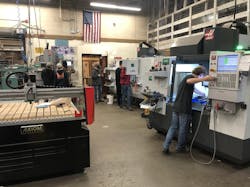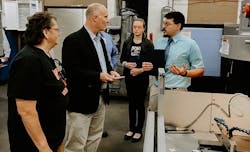How Students at a Michigan High School Are Machining Their Future
Working as a machinist has evolved. It’s no longer the dirty work it used to be; it is clean and hi-tech and as much about programming and integrating computer systems as it is about problem-solving in industries like aerospace, automotive, consumer packaging and medical device manufacturing.
This message resonates with Gen Z, often referred to as the “toolbelt generation.” With the rising cost of higher education, many Gen Zers are opting for vocational training and immediate job placement over a traditional college education.
This is good news for the manufacturing industry. As the older generations age out, the industry is facing a talent shortage of skilled machinists, technicians and engineers. Experts say this skills gap is adding up to a deficit of 4 million jobs that will need to be filled by 2030. According to Deloitte and the Manufacturing Institute, 2.1 million jobs could go unfilled if the industry cannot attract young people to pursue modern manufacturing careers.
Educators, many of whom are machinists themselves, play a major role in empowering the next generation. Kyle Sisco, an educator at Ogemaw Heights High School in West Branch, Mich. is one such individual.
For more than five decades, Ogemaw Heights High School has provided students with hands-on experience in precision machining, opening doors to rewarding careers in manufacturing.
“Ironically, my journey through this very program in 2000 brought me back full circle as an educator,” Sisco said. “As a high school student, I took the machine tool class and immediately fell in love with machining. My instructor, Mr. Petri, was more than just a teacher—he was an inspiration. His passion for the trade was contagious, sparking an interest [for me] and many of my classmates. His guidance helped shape my career, and I can confidently say I wouldn’t be teaching today if it weren’t for him,” said Sisco.
After working for years as a computer numerical control (CNC) machine operator, in 2007, Sisco was hired as the machine tool instructor, stepping into the very classroom that had shaped his future.
Real-world Opportunities
For years, Sisco dreamed of giving his students the opportunity to create real parts for real-world use. He believed that when students knew their work had a true purpose, they would take greater pride in it. At the same time, running a machine tool class is expensive; material costs add up quickly, especially when projects have no practical application. By introducing production-run assignments, he saw an opportunity to bridge education and industry in a way that benefited both the students and the community.
In the spring of 2017, while showing an advisory partner a part that the students had machined for a class project, an opportunity opened. The advisor was so impressed that he asked the class to make more for his shop. The parts passed inspection, and the shop owner was so pleased that he donated additional material to support the program.
From there, their reputation grew. The school administration took notice, and soon, the students were producing parts for the district. The first project was machining classroom number signs. Students handled every aspect—from design and ordering materials to machining, plating, inspecting, assembling and delivering. The high school project expanded to the entire district, resulting in nearly 700 parts being produced by the students.
Work-based Learning: Preparing Students for Industry
Since the first production run, the students have gone on to machine parts for local agencies, factories, manufacturing facilities and even NASA. Under Sisco’s guidance, Ogemaw Heights won a project to machine parts for experiments on the International Space Station (ISS), through the NASA HUNCH (High Schools United with NASA to Create Hardware) program. Sisco entrusted the entire process—programming, setup, inspection and production—to his students.
The students use Mastercam as their CAD/CAM software of choice to create programming processes and toolpaths. Mastercam is a proud partner of NASA HUNCH and provides no-cost timed licenses to program participants. The participating schools receive access to the Mastercam Educational Suite of products. Students at Ogemaw Heights use powerful tools in Mastercam, such as “Verify” and “Backplot,” to simulate their toolpaths and check for potential collisions before sending the program to the machine.
The students produced 62 parts in their first run, using only one of the four bars of material they were given. When students were confused by all the leftover material, Sisco contacted the NASA HUNCH program manager to find out what to do. The NASA HUNCH program manager, pleasantly surprised, told them to run additional parts.
The students made 200 parts overall, with 100% of them passing inspection. Not only did the parts ride aboard the first SpaceX flight to the ISS, but the accomplishment earned a visit from a NASA program director. The ongoing relationship with NASA has enabled Sisco’s students to continue contributing to space exploration. They are machining covers for cube satellites that will be launched from the ISS to collect data for eight years, demonstrating the advanced level of projects his students are capable of handling.
Today, advanced students participate in the Work-Based Learning Project, an educational partnership where students manufacture real parts for real companies.
One of their proudest moments came last year when a pair of students kept a local factory in business. The company needed driveshaft gears machined out of 303 stainless steel, a non-magnetic, austenitic stainless steel that is not hardened by heat treatment. It’s a complex task requiring two CNC lathe setups and five CNC mill setups. The students successfully completed the order, ensuring the company’s production line remained operational.
From Classrooms to Career
This model has not only given students valuable hands-on experience but has also opened doors for employment. Many Ogemaw students participate in paid co-op positions during their junior and senior years. Through the program, they leave school after lunch to work at local manufacturers, earning both school credit and a paycheck. For many, this opportunity has led to full-time employment after graduation.
“Looking back, it’s incredible to see how far we’ve come. What started as a dream has turned into a reality—our students are not only learning valuable skills but are actively contributing to their community and shaping their futures in the process,” said Sisco.
Editor’s Note: Machine Design’s WISE (Workers in Science and Engineering) hub compiles our coverage of workplace issues affecting the engineering field, in addition to contributions from equity seeking groups and subject matter experts within various subdisciplines.
About the Author

Peter Mancini
Education Manager, Mastercam
Peter Mancini has more than three decades of experience in educational management and sales within the technology sector. Currently serving as the education manager at Mastercam since August 2017, Mancini oversees the company’s global educational strategy and programs. Prior roles include senior sales manager and education sales manager at 3Dconnexion, regional manager at Intelitek and various positions at Autodesk, including university programs manager and regional education sales manager. Mancini began his career as education sales manager at Cadkey. Educational qualifications include a degree from the University of Connecticut School of Business, completed between 1984 and 1989.




